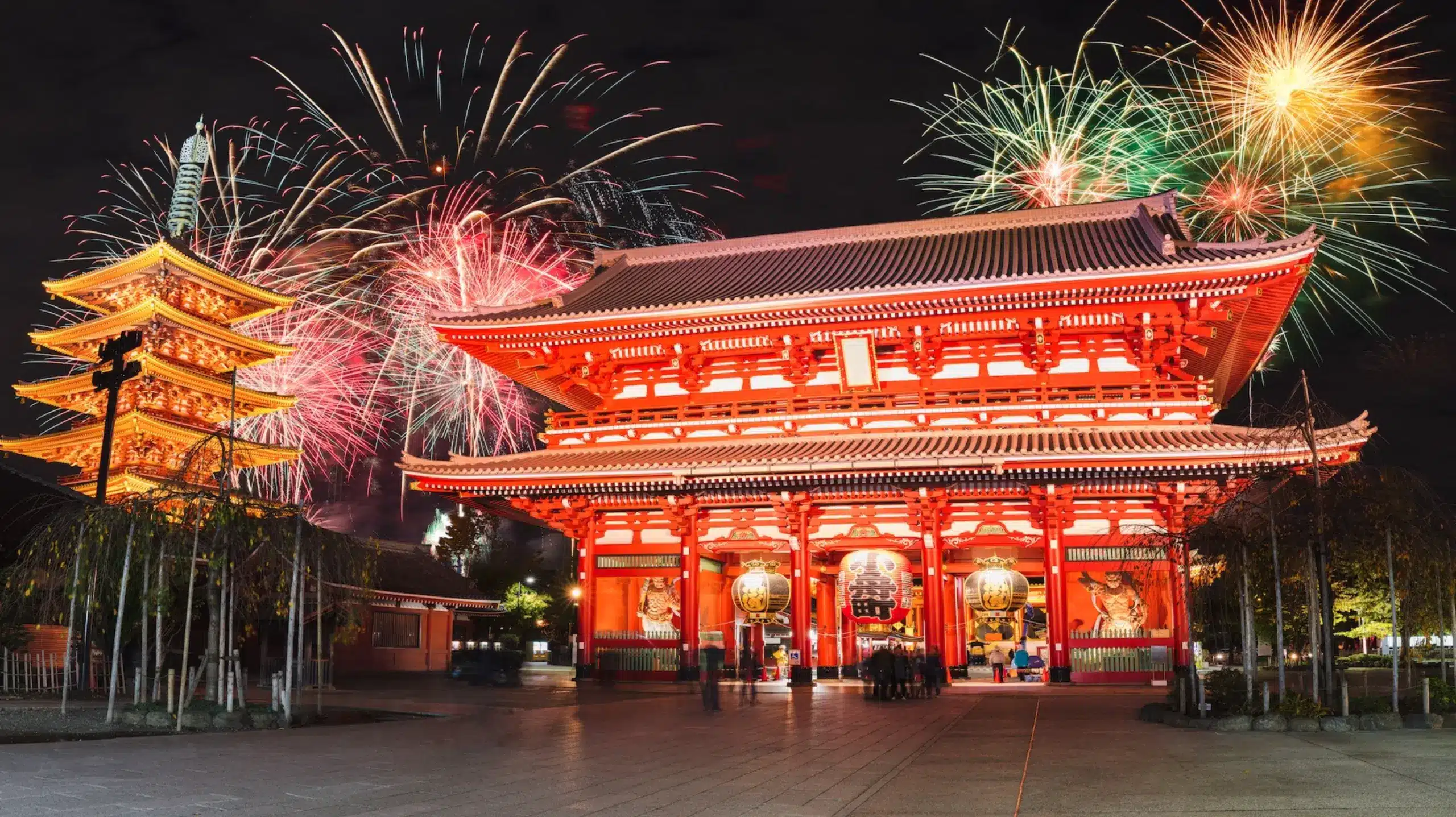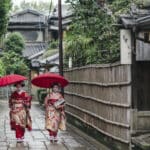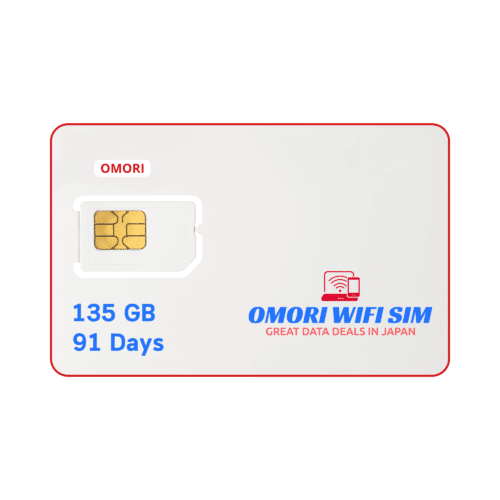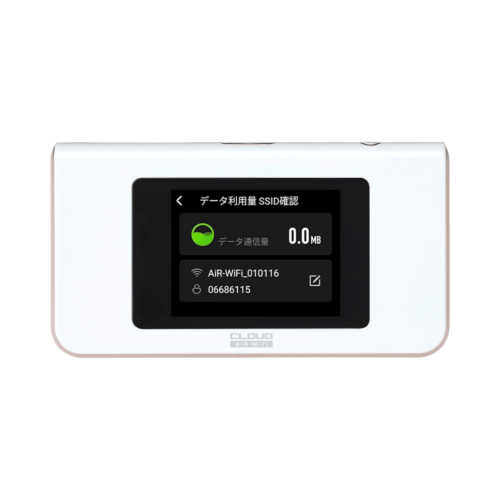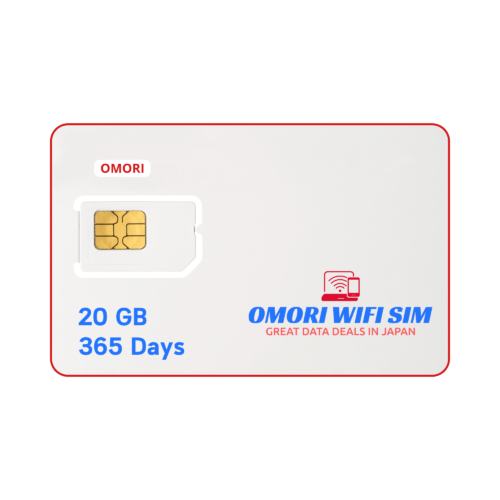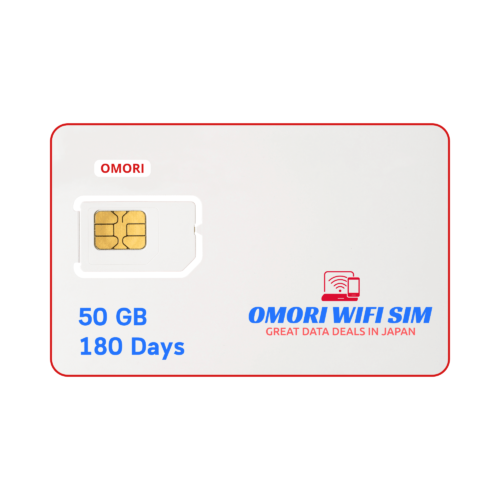Japan mag zwar für seine harte Arbeit in der Wirtschaft bekannt sein, doch das Land hat auch eine reiche Kultur und Tradition. Das japanische Kulturerbe, zu dem auch die japanische Küche gehört, ist einer der Gründe, warum viele Touristen das Land besuchen.
Wenn Sie Weihnachten in Japan verbracht haben, wissen Sie, dass die chinesische und koreanische Gemeinschaft das japanische Neujahrsfest feiert. Andere feiern jedoch in der Regel das gregorianische Neujahrsfest.
Das Neujahrsgefühl in Japan
Dekorationen sind ein wesentlicher Bestandteil der japanischen Neujahrstraditionen. Sobald Weihnachten vorbei ist, beginnen japanische Weihnachtsdekorationen, den Weg für verschiedene Dekorationsstücke freizumachen.
Der Kadomatsu, auch Torkiefer genannt, ist eine der beliebtesten Neujahrsdekorationen Japans. Die Kadomatsu wird aus Kiefern-, Bambus- und Pflaumenzweigen hergestellt. Es ist ein Willkommenssymbol für Erntegötter und Ahnengeister. Es wird angenommen, dass es Glück für das kommende Jahr bringt.
Shimenawa, oder heiliges Seil, ist eine weitere Dekoration, die Sie wahrscheinlich während der Feierlichkeiten zum neuen Mondjahr antreffen werden. Japan hat ein umfangreiches kulturelles Erbe und die Japaner glauben, dass das heilige Seil böse Geister abwehrt und die Glücksgötter willkommen heißt.
Wenn man in Japan herumgeht und den Leuten ein frohes neues Jahr wünscht, gehen die Japaner noch einen Schritt weiter und dekorieren mit dem Kagami Mochi (Spiegelreiskuchen). Dazu gehören zwei gestapelte Reiskuchen mit einer kleinen Orange (daidai) obenauf gelegt. Der Spiegelreiskuchen wird in der Nähe von Shinto-Altären oder an prominenten Stellen im Haus platziert, um Wohlstand und Langlebigkeit zu symbolisieren.
Lokale Traditionen und Praktiken
In Chukugai können Sie Japans Version von Chinatown erleben und dort finden in Japan die Neujahrsfeierlichkeiten statt. Wenn das Mondjahr nicht Ihr Ding ist, können Sie mit anderen an einem Schrein beten und den Sonnenaufgang beobachten.
Hatsuhinode
Wenn Sie Silvester in Tokio oder anderswo in Japan verbringen, vergessen Sie nicht die Hatsuhinode. Es bedeutet „erster Sonnenaufgang“ und Sie können sich vielen Japanern anschließen, die auf den ersten Sonnenaufgang des neuen Jahres warten.
Sie können diesen Aspekt der japanischen Neujahrstraditionen und -bräuche genießen, indem Sie den Fuji besteigen, um den ersten Sonnenaufgang zu erleben. Beobachten Sie den Sonnenaufgang von Inobusaki, Ibaraki, Tokyo Skytree, Berg Tsukuba in der Nähe von Tokiooder andere erhöhte Räume.
Hatsumode
Der erste Tempelbesuch des Jahres ist fester Bestandteil der japanischen Tradition. Bei diesem Besuch beten die Menschen für ihre Herzenswünsche und kaufen manchmal Glücksbringer und Amulette.
Hatsumode ist der erste Tempelbesuch im neuen Jahr. Die Teilnahme am Hatsumode bedeutet, dass Sie sich anderen im ganzen Land beim Gebet zum ersten Besuch anschließen und um göttlichen Schutz, Gesundheit und Erfolg beten.
Kakizome
Dies bedeutet „erste Kalligraphie“. Für Einheimische kann Neujahr in Tokio oder anderswo in Japan die Kunst persönlicher Ziele oder glückverheißender Sätze in traditioneller japanischer Schrift beinhalten. Dies kann eine Möglichkeit sein, das neue Jahr mit Absicht zu beginnen.
Hatsuyume
Der erste Traum des Jahres lässt Sie wissen, was das kommende Jahr für Sie bereithält. Wenn Sie vom Fuji, einem Falken oder einer Aubergine träumen, wird Ihnen im neuen Jahr Glück zuteil.
Nengajo
Das Neujahrserlebnis eines Einwohners oder Touristen in Tokio ist ohne das Nengajo unvollständig. Das Versenden und Empfangen von Postkarten mit guten Wünschen gehört zu den Neujahrstraditionen und -bräuchen.
Traditionelle Neujahrsgerichte
Was wäre ein Fest ohne Essen? In Japan kann man das neue Jahr mit verschiedenen Gerichten feiern. Zwei bekannte Gerichte sind das Silvestergericht und das traditionelle Neujahrsessen.
Toshikoshi Soba
Die Jahreswechselnudeln werden von Familie und Freunden gegessen, wenn sie den Jahreswechsel feiern. Familien essen während Osechi typischerweise die traditionellen Schüsseln mit einfachen Nudeln, während Freunde vor dem neuen Jahr noch gemeinsam feiern und essen gehen.
Osechi Yori
Während der Neujahrsfeierlichkeiten stößt man häufig auf gestapelte, lackierte Kisten mit Lebensmitteln. Diese enthalten traditionelle Neujahrsgerichte, wobei jedes Gericht eine andere symbolische Bedeutung hat. Das sind die traditionellen Speisen des japanischen Neujahrs.
Die Kuromane oder Sojabohnen symbolisieren beispielsweise Gesundheit und Kazunoko symbolisiert Fruchtbarkeit. In Restaurants und Geschäften können Sie vorgefertigte Pakete kaufen, sodass Sie mit weniger Aufwand an dieser Tradition teilhaben können.
Spaß und Spiele zum Neujahr
Wenn Sie noch nie ein traditionelles japanisches Spiel genossen haben, dann ist das neue Jahr eine Zeit für Sie, dies zu tun. Sie können verschiedene traditionelle Spiele genießen, wie zum Beispiel die Kurata Dies erfordert schnelles Denken und Kenntnisse der klassischen japanischen Poesie.
Koma ist ein weiteres Spiel, das Sie mit Kreiseln spielen können. Sie können auch wählen, zu spielen Hanetsuki, ein Spiel, das Ähnlichkeiten mit Badminton aufweist.
Futubukuro
Die Japaner glauben fest an Glück und versuchen, mit viel Glück ins neue Jahr zu starten. Glück kann man auch von Unternehmen erwarten, die versuchen, überschüssige Lagerbestände abzubauen.
Wenn Sie während der Neujahrsfeierlichkeiten in Geschäfte oder Cafés gehen, können Sie eine Happy Bag oder Lucky Bag kaufen, auch bekannt als Fukuburo. Auf diesen Taschen sind Kanji-Schriftzüge zu lesen und sie enthalten geheimnisvolle Leckereien für die Käufer.
Der Kauf eines Fukuburo bedeutet, dass Sie Dinge wie Gadgets und Kleidung für etwa die Hälfte des Preises bekommen können. Da es sich jedoch um ein Glücksspiel handelt, kann es auch sein, dass Sie am Ende etwas ausgeben, das Ihnen nichts nützt.
Bleiben Sie in Verbindung, während Sie Ihren Urlaub genießen
Wenn Sie in Japan Urlaub machen, um die Weihnachts- und Neujahrsfeierlichkeiten zu genießen, benötigen Sie eine Internetverbindung. So können Sie Ihre Fotos und Videos auf Ihre bevorzugten sozialen Netzwerke hochladen und mit Ihren Lieben zu Hause in Kontakt bleiben.
OMORIWIFI bietet kurzfristige WLAN-SIMs, die Sie während Ihres Aufenthalts in Japan nutzen können. Für ¥6.600 erhalten Sie eine Kurzzeit-SIM für 60 Tage das Ihnen 90 GB Hochgeschwindigkeitsdaten bietet und über das 4G LTE/5G-Netzwerk von Docomo betrieben wird.
Wer es länger möchte, kann sich auch eine 91-Tage-Sim das 135 GB für nur 8.600 ¥ bietet. Sie können es sofort aktivieren und verbinden, ohne dass eine Registrierung erforderlich ist und ohne versteckte Gebühren.
Je nachdem, wie lange Sie in Japan bleiben möchten, gibt es auch kürzere Pläne, die 7 Tage, 16 Tage, 31 Tage usw. dauern.
Wer weiß? Vielleicht möchten Sie nach Ihrem Urlaub für einen längeren Aufenthalt nach Japan zurückkehren. Wenn das bei Ihnen der Fall ist, können Sie die langfristiger 6-Monats-Plan Damit erhalten Sie monatlich 100 GB mit der Option, alles im Voraus oder monatlich zu bezahlen.
Wenn Sie sich den Stress ersparen möchten, Ihrem Telefon eine neue SIM-Karte hinzuzufügen, können Sie sich für die Pocket-WLAN, das Ihnen unbegrenzte 5G-Konnektivität bietet. Abgesehen von einem unbegrenzten Internettarif bietet das Pocket-WLAN den zusätzlichen Vorteil, dass es mit Ihrem Laptop oder mehreren Geräten verwendet werden kann, die Sie möglicherweise mitnehmen möchten, wenn Sie die Neujahrsfeierlichkeiten erleben.
Abschluss
Ein Neujahrsurlaub in Japan bedeutet, dass Sie die dichte Kultur und die Bräuche des Landes erleben können. Sie können mit den Japanern feiern, indem Sie ihr Essen genießen, an kulturellen Spielen teilnehmen und einkaufen Futubukuro und stellen Sie gleichzeitig sicher, dass Sie über die Dienste von OMORIWIFI mit Ihren Lieben und dem Rest der Welt in Verbindung bleiben.



